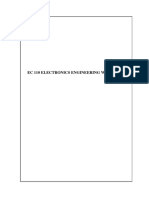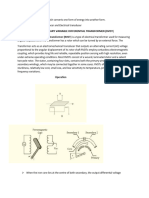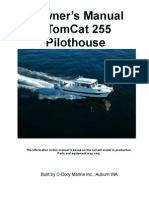PreventVibrationDamageTCsRTDSensors WhitePaper PDF
PreventVibrationDamageTCsRTDSensors WhitePaper PDF
Uploaded by
hernangCopyright:
Available Formats
PreventVibrationDamageTCsRTDSensors WhitePaper PDF
PreventVibrationDamageTCsRTDSensors WhitePaper PDF
Uploaded by
hernangOriginal Title
Copyright
Available Formats
Share this document
Did you find this document useful?
Is this content inappropriate?
Copyright:
Available Formats
PreventVibrationDamageTCsRTDSensors WhitePaper PDF
PreventVibrationDamageTCsRTDSensors WhitePaper PDF
Uploaded by
hernangCopyright:
Available Formats
WHITE PAPER
Preventing Vibration Damage to Thermocouples and RTD Sensors
Thermocouples and resistance temperature detectors, measurements. Platinum is the most preferred wire, since it
or RTDs, are the most commonly used temperature sensors. provides the best accuracy over the broadest temperature
Thermocouples operate on the principle of the Seebeck effect, range. ASTM E1137 is the international standard that defines
which states that two dissimilar metals joined at two junctions tolerances for platinum resistance sensors. It is frequently
generate an electromotive force, or EMF, at the junctions. used as one of the criteria for selecting a temperature
The metals react to changes in temperature to produce an sensor, as RTDs manufactured and tested according to this
EMF voltage in relation to the difference in temperature at the specification offer greater reliability and better performance.
junction. RTDs function on the precept that electrical resistance
PROBE
TIPS TIPS ART
CUTAWAY CUTAWAY ART
increases with increasing temperature. The types of metal used
to fabricate the sensor impact accuracy, measurement range,
response time and resistance to environmental stressors such
as vibration.
Sensor Design of Thermocouples and RTDs
Grounded
Exposed Exposed
Ungrounded Ungrounded
TFD Thin-Film RTD shown magnified
Thin-film RTDs offer substantially more vibration protection
than wire-wound RTDs. They are produced by depositing
Grounded Junction, Ungrounded Junction, a thin film of passivated platinum on a ceramic substrate.
OMEGACLAD® Probes OMEGACLAD® Probes
An electrical circuit is etched into the material to create the
preferred resistance. These sensors display a practically
Thermocouple junctions may be grounded or ungrounded. linear temperature-resistance curve. Therefore, they provide
They are often covered with protective metal but may be left highly accurate and consistent measurements over a broad
exposed to improve response time. Grounding is frequently temperature range. Their compact size gives them the
required to prevent buildup of static charge, which may advantage of faster response times and greater resistance to
negatively impact accuracy. However, if the thermocouple thermal shock and vibration.
is grounded to machinery or other electrically powered
equipment, circuit noise may interfere with the measurement. Challenges Presented to Temperature
A number of different metal combinations are used in the Measurements in the Presence of Vibration
construction of thermocouples. Each is classified according to
temperature range and acceptable measuring environments. Vibration can cause mechanical stress in the wires of
Thermocouples encased in metal are quite robust and, on thermocouples and RTDs. Thermocouples are subject to
average, much less susceptible to vibration than RTDs. vibration fatigue, which can lead to insulation failure and short
circuits. This may be evident from intermittently high readings
resulting from the measurement being taken at the short
rather than at the junction. Wire-wound RTDs are especially
susceptible to vibration damage. The fine platinum wire used
to wind the sensor has a typical diameter of 15 to 35 microns
and is quite fragile. A broken or damaged RTD sensor wire
may result in:
• An open circuit
• Noisy signals
• Sporadically high temperature measurements
1PT100G
Glass Wire-Wound RTDs Decalibration is another fault condition that may occur in
thermocouples exposed to vibration. This is the process
whereby the structure of the wire is altered to where the
RTDs are available in wire-wound or thin-film types. Wire- voltage-temperature characteristics no longer conform to
wound sensors are highly accurate. They are made by winding international standards. The major concern with decalibration
copper, nickel or platinum wire around a glass or ceramic core is that the temperature measurements appear to be
to which the wire is also fused. Glass-core sensors can be accurate. The readings will drift gradually over time. Testing
immersed in most liquids without protection while those with a the thermocouple against a known temperature is the most
ceramic core offer stability for exceptionally high temperature common method of detecting decalibration.
omega.com / info@omega.com / 800.826.6342
© 2015 OMEGA Engineering, Inc. All rights reserved.
Types of Vibrations that Affect Sensors
Machine vibrations are common in industrial processes.
They can arise from the movement of motors, pumps or
compressors. The propensity to cause damage is proportional
to the amplitude and frequency of the vibration. The amplitude PR-31 RTD Probe
is the force being applied to an object that is producing the
vibration. For example, the speed of rotation in an electric
motor will contribute to the amplitude of vibration. The faster
the motor rotates, the greater the amplitude. Frequency is
also a factor in the severity of vibration. It is the rate at which The M12M Series thermocouple probes can be used exposed,
a mechanical device moves back and forth under force. A mounted into the process, or in a thermowell. The probes are
machine can vibrate in multiple directions with varying rates available as a Type K thermocouple with Inconel 600 sheaths
of amplitude and frequency. or a Type J with 304 stainless steel sheaths. The Type K
has a temperature range between -40 and 1150°C, and the
Acoustical vibrations are generated by a large number of Type J has a temperature range of -40 to 600°C. The M12M
mechanical systems, such as turbines and engines, as well comes standard with an ungrounded junction; a grounded
as human voices and vehicle traffic. When acoustical noise junction is optional.
enters a structure, it becomes structural vibration. Sound
waves can travel anywhere there is air flow; therefore, they can
come from any direction. Reverberation is the continuance of
sound after the original has ceased. This is the result of sound
waves reflecting from surfaces. Acoustic characteristics can
vary depending on the size and shape of objects they reflect
from, making it difficult to predict how they will react.
Flow-induced vibrations result from the interaction of forces M12M Thermocouple Probe
between fluid flow and the inertia of structures immersed in
or conveying it. Fluid flow is a source of energy capable of
producing mechanical and structural vibration. In cylindrical
structures, vibrations are classified as either axial-flow- Conclusion
induced or cross-flow-induced, depending upon the angle of Choosing the right RTD or thermocouple for you application
inward flow in relation to the cylinder axis. will optimize performance and prevent sensor damage.
Thermocouples are a versatile and cost-effective means
Vibration Resistant Thermocouples and RTDs of temperature measurement and offer the best protection
against vibration. Wire-wound RTDs offer superior accuracy
The OMEGA PR-21SL RTD is designed for use in thermowells and a wider measurement range but are not as resilient. Thin-
and features spring loading to sustain contact between the film RTDs provide highly accurate and consistent data and
probe and the thermowell in the presence of static and vibration. offer greater resistance to vibration than wire-wound RTDs.
This ensures optimal heat transfer between the thermowell and OMEGA also has custom engineered solutions for very severe
probe and insulates the sensor against vibration. The PR-21SL vibration environments.
RTD can be used in two-, three- or four-wire applications and
fits standard 0.26-inch bore thermowells. An adjustable, self- Source
gripping spring allows it to be used in shorter thermowells.
https://www.isa.org/standards-and-publications/isa-publications/intech-
magazine/automation-basics/thermocouples-versus-rtds/#sthash.
Ce39GHYe.dpuf
http://www.omega.com/temperature/z/pdf/z045-047.pdf
http://www.aps.anl.gov/Accelerator_Systems_Division/Radio_Frequency/
Presentations_and_Lectures/Cross_Training/Documents/Bromberek_
PR-21SL RTD Temperature%20Measurement%20Presentation_2.09.pdf
http://www.omega.com/temperature/z/pdf/z021-032.pdf
OMEGA’s PR-31 RTD probe is bendable and vibration-
resistant. The probe is constructed of 316 stainless steel, https://books.google.com/books?id=CAvSMyoP1wcC&pg=PA408&lpg=P
and the mineral-insulated cable allows the probe to be bent. A408&dq=types+of+flow+induced+vibrations&source=bl&ots=LrXYIS4N0
7&sig=YzDceKHr4k2eBTFxQD3v74XZfLY&hl=en&sa=X&ved=0CEEQ6A
The PR-31 RTD is vibration tested to MIL-STD-202G, Method EwBmoVChMI1MK29IqixwIVR4wNCh3x9AoP#v=onepage&q=types%20
204D, Condition A and has a measuring range between of%20flow%20induced%20vibrations&f=false
-50 and 500°C. It is available in 100 and 1000Ω and can be
used in 2-, 3- or 4-wire applications. http://www.omega.com/pptst/M12molded.html
omega.com / info@omega.com / 800.826.6342
© 2015 OMEGA Engineering, Inc. All rights reserved.
You might also like
- Preventing Vibration Damage To Thermocouples and RTD SensorsDocument2 pagesPreventing Vibration Damage To Thermocouples and RTD SensorshernangNo ratings yet
- RTD - Theory Temperature PDFDocument6 pagesRTD - Theory Temperature PDFpandit1010No ratings yet
- RTD Standards: AccuracyDocument11 pagesRTD Standards: AccuracyAhmad Adel El TantawyNo ratings yet
- Comparison of Thermocouples, RTDS, and ThermistorsDocument2 pagesComparison of Thermocouples, RTDS, and ThermistorsAlwyzz Happie Raamzz100% (1)
- Resistance Temperature Detector (RTD) - Principle of Operation, Materials, Configuration and BenefitsDocument5 pagesResistance Temperature Detector (RTD) - Principle of Operation, Materials, Configuration and BenefitsSaad NasirNo ratings yet
- Tem. MeasurementsDocument104 pagesTem. MeasurementsRavindrasinh DabhiNo ratings yet
- Sensor Compare ChartDocument3 pagesSensor Compare ChartPopescu QescuNo ratings yet
- Electronics Workshop Manual 2Document141 pagesElectronics Workshop Manual 2Manu Yadav100% (1)
- Overview of Temperature MeasurementDocument54 pagesOverview of Temperature MeasurementGurtej SinghNo ratings yet
- Applied Physics TYBscDocument95 pagesApplied Physics TYBscAtharv PatadeNo ratings yet
- ResistorDocument52 pagesResistormythony100% (1)
- RTD BasicsDocument5 pagesRTD BasicsMourougapragash SubramanianNo ratings yet
- Low Voltage MeasurementDocument2 pagesLow Voltage Measurementsina123No ratings yet
- Field Engineering Sciences: Sensors and Measurement Systems MEC372Document34 pagesField Engineering Sciences: Sensors and Measurement Systems MEC372mohamed orifNo ratings yet
- Thermocouple Questions and AnswersDocument12 pagesThermocouple Questions and AnswersJêmš Navik0% (1)
- To Study Resistance Temperature DetectorsDocument21 pagesTo Study Resistance Temperature DetectorsStuti AgrawalNo ratings yet
- A Rotary Variable Differential Transformer (RVDT)Document4 pagesA Rotary Variable Differential Transformer (RVDT)Proxima YusNo ratings yet
- Difference Between RTD, Thermocouple and ThermistorDocument3 pagesDifference Between RTD, Thermocouple and ThermistorVenkata Suresh MandavaNo ratings yet
- Rtds - or Resistance Temperature Detectors - Are Temperature Sensors That Contain A Resistor ThatDocument6 pagesRtds - or Resistance Temperature Detectors - Are Temperature Sensors That Contain A Resistor Thatmuhammad aliNo ratings yet
- TransducersAQ 2017Document102 pagesTransducersAQ 2017dekhte rahoNo ratings yet
- Foil ResistorDocument3 pagesFoil ResistorMarkee ChoiNo ratings yet
- Lecture 9Document22 pagesLecture 9havishalhumNo ratings yet
- Thermocouple PDFDocument6 pagesThermocouple PDFibrahim2129047No ratings yet
- Resistance ThermometryDocument52 pagesResistance ThermometryRAJANo ratings yet
- Resistors ReportDocument21 pagesResistors ReportFaizal Usop PatikamanNo ratings yet
- RTDDocument10 pagesRTDaadieNo ratings yet
- What Is A Temperature Sensor?: ThermocouplesDocument2 pagesWhat Is A Temperature Sensor?: ThermocouplesanuradhaNo ratings yet
- RTD Theory: Platinum Thin Film RTDDocument5 pagesRTD Theory: Platinum Thin Film RTDMurali Krishna GbNo ratings yet
- 6Document52 pages6Virendra Kumar PareekNo ratings yet
- RTDDocument4 pagesRTDCss GaneshNo ratings yet
- RTDvs TCDocument2 pagesRTDvs TCNarain RamNo ratings yet
- Resistance ThermometersDocument3 pagesResistance ThermometersAsutoshNo ratings yet
- Neutral Grounding ResistorDocument4 pagesNeutral Grounding ResistorViswanathan VNo ratings yet
- Resistance Temperature Detectors: Element Material Temperature Range Benefits (%/ C)Document4 pagesResistance Temperature Detectors: Element Material Temperature Range Benefits (%/ C)Harish SundarNo ratings yet
- Resistance ThermometrDocument9 pagesResistance Thermometrgopir28No ratings yet
- A Comprehensive Overview of Thermistor Circuit Principle, Types, and DiagramDocument12 pagesA Comprehensive Overview of Thermistor Circuit Principle, Types, and DiagramjackNo ratings yet
- Resistor Definition and Symbol: o o o o o o o oDocument7 pagesResistor Definition and Symbol: o o o o o o o oGio Lagadia100% (1)
- R Vs T Relationship of Various Metals: SensorsDocument6 pagesR Vs T Relationship of Various Metals: SensorsAnbu AyyappanNo ratings yet
- BeeDocument22 pagesBeebiswajit7sarkarNo ratings yet
- 2 Car Sensors V1-TemperatureDocument35 pages2 Car Sensors V1-TemperatureWNo ratings yet
- RTD, Thermocouple, Thermistors, Manometer, Bourdon TubeDocument36 pagesRTD, Thermocouple, Thermistors, Manometer, Bourdon TubeDINESH KUMAR DRAVIDAMANI100% (1)
- ThermocoupleDocument15 pagesThermocoupleHuzaimah JaiminNo ratings yet
- Sensors in WordDocument14 pagesSensors in WorddawitNo ratings yet
- Thermocouple and RTD Wire: Reference JunctionsDocument2 pagesThermocouple and RTD Wire: Reference JunctionsFelipe GustavoNo ratings yet
- Anixter Thermocouple and RTD Wire Wire Wisdom enDocument2 pagesAnixter Thermocouple and RTD Wire Wire Wisdom enFelipe GustavoNo ratings yet
- C-450eb NGR SigmaDocument4 pagesC-450eb NGR SigmaMARCO FERNANDEZNo ratings yet
- Emi 7Document79 pagesEmi 7viju_310No ratings yet
- Field Engineering Sciences: Sensors and Measurement Systems MEC372Document16 pagesField Engineering Sciences: Sensors and Measurement Systems MEC372mohamed orifNo ratings yet
- Instrumentation Lab.: RTD Thermistors Thermocoupl eDocument31 pagesInstrumentation Lab.: RTD Thermistors Thermocoupl eGAURAV SINGHNo ratings yet
- Resistance Temperature Detectors (RTDS)Document14 pagesResistance Temperature Detectors (RTDS)ramprabhakarjNo ratings yet
- Hot Wire AnemometerDocument86 pagesHot Wire AnemometerRajashree Ravi100% (1)
- Instrumentation SensorsDocument145 pagesInstrumentation SensorsGulfam ShahzadNo ratings yet
- Temperature Monitoring in The IndustryDocument60 pagesTemperature Monitoring in The IndustryAnish MajumderNo ratings yet
- Controllers Boiler+tc'sDocument36 pagesControllers Boiler+tc'sAnonymous nw5AXJqjdNo ratings yet
- Thermocouple Wire ReportDocument16 pagesThermocouple Wire ReportshadiNo ratings yet
- PLC WiringDocument7 pagesPLC WiringInstrumentation ToolsNo ratings yet
- PE Basic RulesDocument1 pagePE Basic RuleshernangNo ratings yet
- Technical Information Letter: Energy Services Engineering Product Service TIL 1564Document5 pagesTechnical Information Letter: Energy Services Engineering Product Service TIL 1564hernangNo ratings yet
- Technical Information Letter: Energy Services Engineering Product Service TIL 1564-R1Document4 pagesTechnical Information Letter: Energy Services Engineering Product Service TIL 1564-R1hernangNo ratings yet
- GE Energy: Spare Parts CatalogueDocument1 pageGE Energy: Spare Parts CataloguehernangNo ratings yet
- GE Energy: Spare Parts CatalogueDocument1 pageGE Energy: Spare Parts CataloguehernangNo ratings yet
- Technical Information Letter: Energy Services Engineering Product Service TIL 1531-R1Document5 pagesTechnical Information Letter: Energy Services Engineering Product Service TIL 1531-R1hernangNo ratings yet
- GE Energy: Spare Parts CatalogueDocument1 pageGE Energy: Spare Parts CataloguehernangNo ratings yet
- GE Energy: Spare Parts CatalogueDocument1 pageGE Energy: Spare Parts CataloguehernangNo ratings yet
- GE Energy: Spare Parts CatalogueDocument1 pageGE Energy: Spare Parts CataloguehernangNo ratings yet
- GE Energy: Spare Parts Catalogue NomenclatureDocument47 pagesGE Energy: Spare Parts Catalogue NomenclaturehernangNo ratings yet
- W-101 Turbine Section Od'sDocument1 pageW-101 Turbine Section Od'shernangNo ratings yet
- W-101 Shipping Skid PackageDocument3 pagesW-101 Shipping Skid PackagehernangNo ratings yet
- W-101 Compressor Section Axial (w-SHI Spec)Document1 pageW-101 Compressor Section Axial (w-SHI Spec)hernangNo ratings yet
- W-101 Turbine Section Run-OutsDocument1 pageW-101 Turbine Section Run-OutshernangNo ratings yet
- Uni2018 12 TensionDocument1 pageUni2018 12 TensionhernangNo ratings yet
- TIL 1304 3 - 9th Stage Stator Casing Hook Fit CrackingDocument4 pagesTIL 1304 3 - 9th Stage Stator Casing Hook Fit Crackinghernang100% (1)
- Shroud Blocks For GE Gas TurbinesDocument2 pagesShroud Blocks For GE Gas Turbineshernang100% (3)
- FPGA SlidesDocument16 pagesFPGA SlidesAashrey JainNo ratings yet
- Riello Multi Sentry MCT MST PDFDocument6 pagesRiello Multi Sentry MCT MST PDFfedericosanchezNo ratings yet
- Sbas 022 DDocument27 pagesSbas 022 DWilson Yecit OrtizNo ratings yet
- LG 32lg3000 Chassis Ld84a LCD TV SMDocument26 pagesLG 32lg3000 Chassis Ld84a LCD TV SMEmma FrostNo ratings yet
- Sw4548e PDFDocument152 pagesSw4548e PDFGA16DET100% (1)
- Manual 20070755 0 Ciao PDFDocument120 pagesManual 20070755 0 Ciao PDFHurduc IonutNo ratings yet
- Embedded Coder - Getting Started GuideDocument123 pagesEmbedded Coder - Getting Started GuideAngamuthu AnanthNo ratings yet
- Telit GE910-QUAD DatasheetDocument2 pagesTelit GE910-QUAD DatasheetChristian Guardia CalderónNo ratings yet
- Avocent Vertiv 18.5 Rack Console - BrosuraDocument4 pagesAvocent Vertiv 18.5 Rack Console - BrosuraMarius SimonNo ratings yet
- Active and Passive FiltersDocument11 pagesActive and Passive FiltersHemanshu DasNo ratings yet
- UM-OMS Lite 1.40.00 - 20130603 PDFDocument51 pagesUM-OMS Lite 1.40.00 - 20130603 PDFjay_pNo ratings yet
- Control Unit For Emergency Gensets With Analogue Inputs Kea 071 AnlDocument1 pageControl Unit For Emergency Gensets With Analogue Inputs Kea 071 AnlrafatNo ratings yet
- Dr. K. Lal Kishore: Registrar & Professor of Electronics & Commn. Engg.Document19 pagesDr. K. Lal Kishore: Registrar & Professor of Electronics & Commn. Engg.manpreetsingh3458417No ratings yet
- General Procedures For Escalators & Moving Walkways - Doc-1Document2 pagesGeneral Procedures For Escalators & Moving Walkways - Doc-1Bartz SantosNo ratings yet
- Design of A Current Mode PI Controller For A Single-Phase PWM InverterDocument6 pagesDesign of A Current Mode PI Controller For A Single-Phase PWM InverterMai Anh ThưNo ratings yet
- Od116669471594834000 1Document3 pagesOd116669471594834000 1ravi kumarNo ratings yet
- AxioLab A1 PolDocument4 pagesAxioLab A1 PolHeriberto CortesNo ratings yet
- Pulse Amplitude Modulation (Pam)Document5 pagesPulse Amplitude Modulation (Pam)ALINo ratings yet
- Sitrans LR250 Radar Transmitter Instruction ManualDocument175 pagesSitrans LR250 Radar Transmitter Instruction ManualVinay TuliNo ratings yet
- L25500 - SE 14.Xx.00 TroubleshootingDocument14 pagesL25500 - SE 14.Xx.00 TroubleshootingAdrian YapNo ratings yet
- ARM946E-S: Technical Reference ManualDocument218 pagesARM946E-S: Technical Reference Manualvsc2012No ratings yet
- MULTICAL® 602 & Ultraflow®: Installation and User Guide ForDocument24 pagesMULTICAL® 602 & Ultraflow®: Installation and User Guide ForMAT SANI NASIRNo ratings yet
- Acopian Cat Gold Box LinearDocument7 pagesAcopian Cat Gold Box LinearmarkymarkNo ratings yet
- Advance Software EngineeringDocument47 pagesAdvance Software Engineeringarooba abdullahNo ratings yet
- Topic 9 - Motor Starting AnalysisDocument14 pagesTopic 9 - Motor Starting AnalysisAlla Naveen KumarNo ratings yet
- TomCat Owners ManualDocument78 pagesTomCat Owners Manualapi-3745677100% (1)
- Chart Panel: Service Manual (40-36201.01) For Device With Hardware Revision .04Document15 pagesChart Panel: Service Manual (40-36201.01) For Device With Hardware Revision .04Zeljko TomicNo ratings yet
- VT 12040 ManualDocument7 pagesVT 12040 ManualCristi CatalinNo ratings yet
- Material List: Produced On 11/07/2019 With Xpress Selection V8.6.4 - Database DIL 13.8.6Document23 pagesMaterial List: Produced On 11/07/2019 With Xpress Selection V8.6.4 - Database DIL 13.8.6Sicologo CimeNo ratings yet
- Quick Charge Device ListDocument23 pagesQuick Charge Device ListFelipe Scaramelli100% (1)










































































































